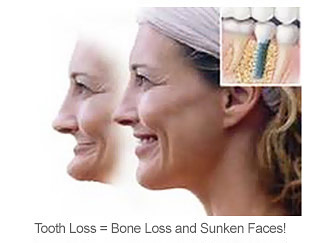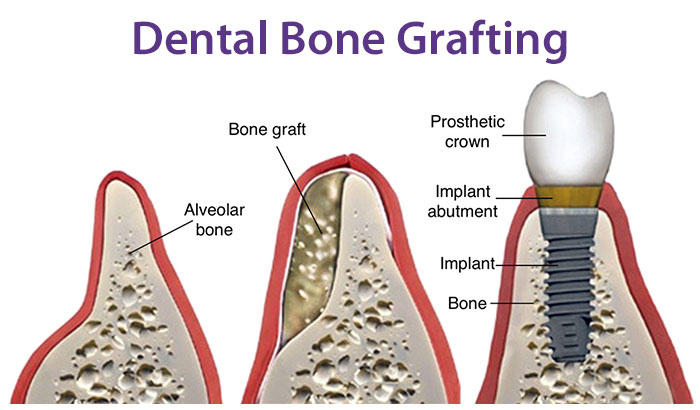Dental Implants & Bone
Dental Implants & Bone Grafting
The Quality & Quantity of Bone in Dental Implant Treatment
One of the major factors that directly affect dental implant success (in addition to at least half a dozen more obscure influences) is the quality and quantity of bone that is available. Dental implants are anchored in the bone essentially like screws in wood. If there is a small amount of bone, or if the bone present is friable and weak (poor quality), seating implants firmly will be problematic. On the other hand, if there is strong, abundant bone, placing a long-lasting implant is relatively easy and certain for a skilled dentist.
When Do I Start Losing Bone?
As soon as a tooth is lost, either from gum disease or from a surgical procedure, the supporting bone starts to melt away. The bone where a tooth is rooted is part of either the upper or the lower jaw. As such, the loss of a tooth affects the major structures of the face, making a replacement an urgent matter.
In the area immediately around the root of a lost tooth, approximately 40% to 60% of the bone disappears within two years of the initial extraction.
 Even worse, the remaining bone also becomes less dense and consequently less able to hold implants. Though the rate of bone loss slows after the first two years, severe damage has already been done, and the amount of bone continues to decline at a slower but still measurable pace.
Even worse, the remaining bone also becomes less dense and consequently less able to hold implants. Though the rate of bone loss slows after the first two years, severe damage has already been done, and the amount of bone continues to decline at a slower but still measurable pace.
This, of course, is one of the reasons why dentures don’t stay in place (see Section 4, “What are the Hidden Dangers of Dentures and Missing Teeth), and why the face changes shape after tooth loss! Please download this document—it shows how tooth loss actually affects facial profile and the muscles of the face!!!!
To accurately assess the amount of bone available, the most advanced technology currently used at dentists’ offices is the CT cone beam scan. See our section on “Cone Beam CT Scans” and “Dental Implant Mistakes and Dangers” for more information on the need for this advanced diagnostic modality.
Bone Grafting and Dental Implants (What if I’ve Lost Too Much Bone Already?)
Luckily, modern oral medicine offers many innovative procedures that enable growing new bone in your jaw. Bone Grafting, for example, take bone from one area in your mouth and move it to another, creating a fresh base for implants. Another procedure, the “sinus lift,” can grow more bone to support the upper back teeth. Ten years ago, this was believed to be impossible, but with these new procedures, almost anyone can gain the benefits of replacing their missing teeth with implants.
It is important to replace missing teeth as soon as they are lost. This will retain as much of the original, healthy bone as possible in the areas where there are no teeth. It’s important not to wait for problems to develop because, untreated, problems are certain to develop sooner or later – probably sooner.
The innovations in dental implant design, combined with improvements in bone grafting materials and surgical techniques, has made the placement of dental implants possible in areas which, half a generation ago, would have been totally off-limits to any practical repair. The patient is often evaluated with advanced technology such as CT cone beam scans, gaining an extremely useful, highly detailed assessment of the bone quality and shape. This is an exciting area of current dental research!
If you’d like to find out if you are eligible for mini dental implants & bone grafting and which options would be best for your situation, click here for your complimentary consultation.
Bone Grafting for Dental Implants
Many people wonder what treatments and procedures are used in cosmetic dentistry, and what their potential and limitations are. Some of the most popular methods performed today are oral bone implants, various types of titanium dental implants, and cosmetic dentistry bonding. Bone Grafting (osseous augmentation) are a frequent choice by people who want to restore chewing function, and to improve their appearance, after suffering dental damage from periodontal disease or injury. Without adequate amounts of bone, many cosmetic or dental implant procedures would be impossible, making the bone grafting the crucial first step in many restorative actions.

Types of Bone Grafts
Depending on the patient, different types of bone grafting are used. Some of the most common materials for bone grafting include:
- Autogenous bone
- Allografts
- Xenografts
- Barrier membranes
Though every one of these materials is excellent at restoring bone quantity and quality safely, quickly, and effectively, autogenous bone grafting are superior to the rest. They are produced from bones in the individual’s own body, which helps prevent rejection of the bone material by the body’simmune defenses. Autogenous bone is frequently taken from areas such as the chin, the jawbone, or the hip.
Allografts are carried out using bone from other individuals, sometimes cadavers. Xenografts are transplants between species, in this case using pig or cow bone transplanted into the human mouth. For bone grafting procedures, we use autogenous bone (the bone of the individual patient themselves) whenever possible.
Some of the most common types of bone grafting procedures include the following:
- Block bone grafting. A block of bone is removed from another area of the body and screwed into position where the dental implant will ultimately be placed. The bone grafting must remain in place for 2 to 6 months before the implant is inserted.
- Bone expansion. This technique enables larger dental implants to be placed. Common areas for bone expansion include the front of the upper jaws. Living bone expands and stretches, enabling bone expansion methods to create larger surfaces. These, in turn, are useful for later dental implant insertion.
- Sinus lift graft. The dental implant surgeon lifts the sinus membranes upward to facilitate insertion of donor bone into floor of the sinus. This is usually done in the area of the upper back molars, when either the sinus has expanded on its own to area where the lost tooth once was, or the bone has withered away in height and width, or both.
Additionally, vertical sinus grafts are possible for smaller grafts, and are typically much less invasive. If an exceptional amount of bone grafting is needed, lateral sinus grafts provide an even more extensive base than the lift graft.
- Socket preservation graft. Each of the teeth in your mouth is held in place by an individual tooth socket. When teeth fall out or are removed, bone in the remaining socket often degenerates. You will generally lose 40% to 60% of the bone that formerly surrounded the roots, both in terms of width and height, within the first year! Socket preservation grafting reduces such bone loss.
- Guided tissue regeneration. Gum tissues grow quickly. To prevent gum tissues from growing over bone grafting, a membrane barrier is often used to cover surgical spaces. This membrane blocks gum tissues from growing into these areas.
Benefits of Grafting Bone for Implants
Anyone who is experiencing bone loss due to infection, periodontal disease, or even trauma will benefit from bone grafting. A very popular method to fill the gaps and spaces between the teeth that have fallen out is replacing the missing bone. Bone grafting prevents additional bone loss, and helps people chew and speak more normally and comfortably.
Expense of bone Grafting?
Most bone grafting procedures in the United States cost between $2,000 and $3,000, depending on the size and type of graft required. Sometimes the bone grafting price is combined with the cost of the dental implants. Some dental patients travel to countries such as Mexico, India, Poland, and Costa Rica to access prices of $65 to $500. Many times, these prices also include the price of the implant.
See our article on the Dangers of Dentures for more information.
Schedule your appointment with bone graft dental in Glen Ellyn today! Call 630-749-2523 or click here to request a consultation.
Check Up
Make an Appointment Today!
Need a Smile Makeover, full mouth reconstruction or cosmetic procedure like veneers or crowns? Set up an appointment now without picking up the phone.
Hours
Monday: 11am – 8pm
Tuesday: 10am – 7pm
Wednesday: 8am – 4pm
Thursday: 7am – 3pm
Friday: Closed
Saturday: Closed
Sunday: Closed
